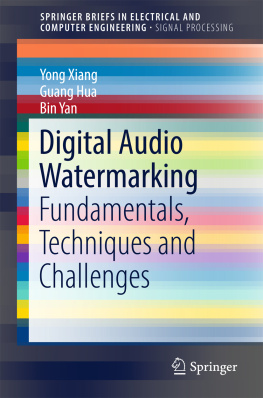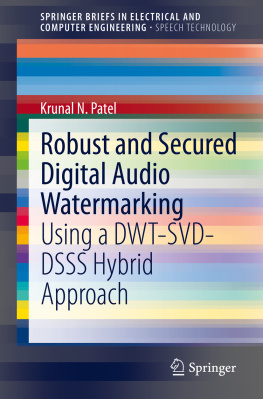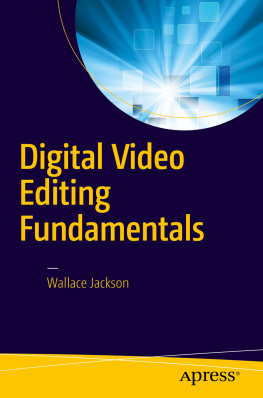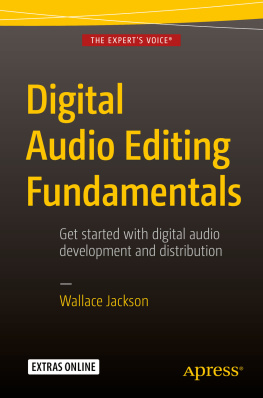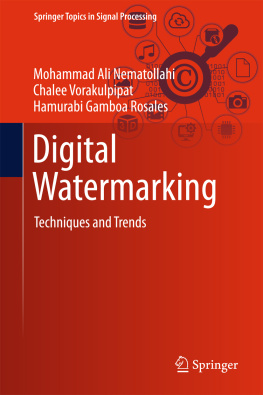Hua Guang - Digital Audio Watermarking: Fundamentals, Techniques and Challenges
Here you can read online Hua Guang - Digital Audio Watermarking: Fundamentals, Techniques and Challenges full text of the book (entire story) in english for free. Download pdf and epub, get meaning, cover and reviews about this ebook. City: Singapore, year: 2017, publisher: Springer Singapore, genre: Home and family. Description of the work, (preface) as well as reviews are available. Best literature library LitArk.com created for fans of good reading and offers a wide selection of genres:
Romance novel
Science fiction
Adventure
Detective
Science
History
Home and family
Prose
Art
Politics
Computer
Non-fiction
Religion
Business
Children
Humor
Choose a favorite category and find really read worthwhile books. Enjoy immersion in the world of imagination, feel the emotions of the characters or learn something new for yourself, make an fascinating discovery.
- Book:Digital Audio Watermarking: Fundamentals, Techniques and Challenges
- Author:
- Publisher:Springer Singapore
- Genre:
- Year:2017
- City:Singapore
- Rating:3 / 5
- Favourites:Add to favourites
- Your mark:
- 60
- 1
- 2
- 3
- 4
- 5
Digital Audio Watermarking: Fundamentals, Techniques and Challenges: summary, description and annotation
We offer to read an annotation, description, summary or preface (depends on what the author of the book "Digital Audio Watermarking: Fundamentals, Techniques and Challenges" wrote himself). If you haven't found the necessary information about the book — write in the comments, we will try to find it.
Hua Guang: author's other books
Who wrote Digital Audio Watermarking: Fundamentals, Techniques and Challenges? Find out the surname, the name of the author of the book and a list of all author's works by series.
Digital Audio Watermarking: Fundamentals, Techniques and Challenges — read online for free the complete book (whole text) full work
Below is the text of the book, divided by pages. System saving the place of the last page read, allows you to conveniently read the book "Digital Audio Watermarking: Fundamentals, Techniques and Challenges" online for free, without having to search again every time where you left off. Put a bookmark, and you can go to the page where you finished reading at any time.
Font size:
Interval:
Bookmark:
- Imperceptibility. Except for the special type of perceptible image watermarking, imperceptibility is probably the most primary concern of a watermarking system. It characterizes how the watermarking system could manage the distortion of original cover content caused by watermark embedding. In audio watermarking, terms such as fidelity, inaudibility, transparency and distortion , refer to the similar concept. We will stick to the term imperceptibility in this book as it more precisely reflects the relationship between embedding distortion and human perception. For image and audio watermarking, imperceptibility is achieved via exploiting the characteristics of human visual system (HVS) and human auditory system (HAS) respectively.
- Robustness. The watermarked content, when released to end users, may undergo uncontrollable processing or even malicious attacks, before we attempt to extract the watermarks from the content. Therefore, it is essentially important for the watermarks to be robust against unintentional or malicious attacks. Typical unintentional attacks include A/D and D/A conversion, equalization, re-encoding, etc., while malicious attacks could be nonlinear scaling, tampering, and so on. Besides, a certain attack could be caused either unintentionally or intentionaly. For example, desynchronization effects could be caused by either A/D and D/A conversion or malicious scaling. Also note that robustness is the most complicated performance criterion for a watermarking system.
- Security. In order not to confuse security with robustness, we confine the concept of watermarking security as the systems capability of preventing unauthorized party to access the watermarking channel, i.e., the systems capability of preventing unauthorized watermarking key detection and watermark extraction. This means that when security is concerned, the adversarys aim is assumed to be watermarking key detection and watermark extraction only, not including watermark removal. Unlike imperceptibility and robustness, the security of audio watermarking systems has been less studied, while the main component to ensure security is the pseudo-random noise (PN) which serves as the key.
- Capacity. The watermarks to be embedded in a given cover content is also called payload. The maximum size of payload, usually in terms of bits, is termed capacity. Since audio signal is a function of time and most audio watermarking schemes segment audio signal into frames before watermark embedding, the embedding capacity could also be characterized by embedding rate with the unit of bits per second or bits per frame.
- Computational Complexity. At last, an audio watermarking system is preferable to be more computationally efficient when it is designed for real-time applications such as broadcast monitoring and second screen systems.
Font size:
Interval:
Bookmark:
Similar books «Digital Audio Watermarking: Fundamentals, Techniques and Challenges»
Look at similar books to Digital Audio Watermarking: Fundamentals, Techniques and Challenges. We have selected literature similar in name and meaning in the hope of providing readers with more options to find new, interesting, not yet read works.
Discussion, reviews of the book Digital Audio Watermarking: Fundamentals, Techniques and Challenges and just readers' own opinions. Leave your comments, write what you think about the work, its meaning or the main characters. Specify what exactly you liked and what you didn't like, and why you think so.

